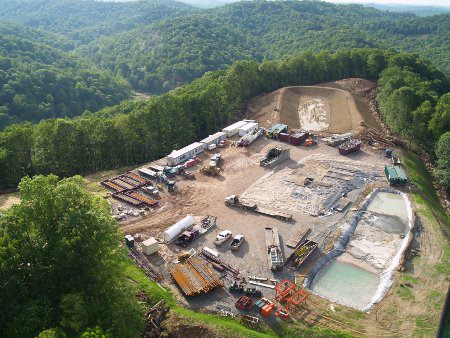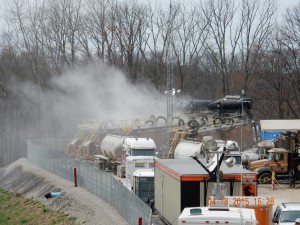- Like
- Digg
- Del
- Tumblr
- VKontakte
- Buffer
- Love This
- Odnoklassniki
- Meneame
- Blogger
- Amazon
- Yahoo Mail
- Gmail
- AOL
- Newsvine
- HackerNews
- Evernote
- MySpace
- Mail.ru
- Viadeo
- Line
- Comments
- Yummly
- SMS
- Viber
- Telegram
- Subscribe
- Skype
- Facebook Messenger
- Kakao
- LiveJournal
- Yammer
- Edgar
- Fintel
- Mix
- Instapaper
- Copy Link

Photo courtesy WV Host Farms
Editors note: This extremely well-researched letter was submitted to the U.S. Forest Service this June, in order to comment on proposed revisions to the Wayne National Forest Management Plan. The letter serves as a compendium of research documenting some of the impacts of fracking on our forests, and ultimately, on us.
I am writing in reference to the current revisions to the Wayne National Forest Management Plan.
One of the most significant activities that I believe will impact the forest ecosystem in a negative way is the expansion of high pressure hydraulic fracking for oil and gas development. I also feel that to allow logging in an effort to “restore oaks” is counterproductive.
This forest was created from a landscape that had been abused and destroyed in part due to misuse, neglect and industrial processes. It has taken decades for the forest ecosystem to revive and for native species of fish, birds, mammals and understory plants to re-colonize the area.
This forest represents a small percentage of the wooded areas in Ohio and is the only national forest in the state. For many people both in and out of state this remains a sanctuary for them to escape their hectic lives and find the peace that nature offers. It also provides a space for recreating, bird watching, fishing, and in some cases a limited amount of medicinal plant harvesting.
While previous forest plans have allowed for multiple uses of the forest, I believe that to call high pressure hydraulic fracking another type of energy development is a travesty for this is NOT the oil and gas development of decades ago. This process is so environmentally destructive it is staggering.
Fracking and all the build-out that this industry requires will dramatically affect that ecosystem. To believe that one can conduct fracking and still sustain a vibrant, healthy forest ecosystem is ludicrous.
The Halliburton loophole legislation of 2005 exempted natural gas drilling from the Safe Drinking Water Act. It exempts companies from disclosing the chemicals used during hydraulic fracturing. Essentially, the provision took the Environmental Protection Agency (EPA) off the job. Fracking is virtually unregulated. Who will guarantee that every stage of the process will be conducted in a way so as not to disrupt the forest ecosystem?
HIGH PRESSURE HYDRAULIC FRACKING
- The Wayne National Forest is home to many medicinal plants such as goldenseal and ginseng. These species have cultural and historical to people in the region. These plants are listed under Appendix II of the Convention on International Trade in Endangered Species (CITES). Medical studies are proving that their value as medicinal plants is more than anecdotal (https://www.hindawi.com/journals/bmri/2018/1843142/) and (https://www.ncbi.nlm.nih.gov/pmc/articles/PMC3100400/) .
- Fracking and the activities that support fracking such as infrastructure development (pipelines, well pads) would harm and even destroy these plants and their seed banks . A study conducted in the Fernow Experimental Forest in West Virginia (http://www.nrs.fs.fed.us/pubs/gtr/gtr-p-78papers/23adamsp78.pdf ) showed that the forest ecosystem was affected by forest clearing, erosion, road building, and vegetation death from direct exposure to fluid spills and there was an increase in the white-tailed deer population. This forest composition is mixed mesophytic and similar to that of Wayne National Forest.
- Fracking wastes have been found to contain water soluble radionuclides that are brought to the surface via produced water. “Elevated levels of chloride and bromide, combined with strontium, radium, oxygen, and hydrogen isotopic compositions, are present in the Marcellus shale wastewaters” (Impacts of Shale Gas Wastewater Disposal on Water Quality in Western Pennsylvania)
Nathaniel R. Warner*, Cidney A. Christie, Robert B. Jackson, and Avner Vengosh*
Division of Earth and Ocean Sciences, Nicholas School of the Environment, Duke University, Durham, North Carolina 27708, United States
Environ. Sci. Technol., 2013, 47 (20), pp 11849–11857
- Peer reviewed studies show that watersheds surrounding frack well pads test positive for these radioactive substances. “Drilling companies deliberately spread wastewater on roads and fields. Pollutants from the water can then contaminate local waterways. Drilling operators sometimes spray wastewater on dirt and gravel roads to control dust, or on paved roads to melt ice. In some Western states, fracking waste is spread on farmland or used to water cattle.” ( Public Employees for Environmental Responsibility, Don’t Drink the Fracking Fluids! Toxic Well Flowback Pumped for Consumption by Wildlife and Livestock (press release), 9 July 2013.). Many such contamination events involve the release of recovered fluid (called “produced water”), which consists of fracturing fluid and salts, heavy metals, hydrocarbons, and radioactive material accumulated from natural underground sources (Howarth et al. 2011a).
- “Fluids from the drill pit were land-applied at two locations on the Fernow in June 2008, with nearly immediate impacts on vegetation. After the first fluid application site, many trees, shrubs, and understory plants showed immediate responses to the fluid application, with leaves turning brown, wilting, and subsequent leaf and bud mortality. We also observed that taller trees, whose leaves were not contacted by the fluids, also began showing decline symptoms about 10 days after the ground vegetation; these symptoms included leaf browning, leaf curling, and premature leaf drop. Premature leaf fall ranged from 227 to 1,395 kg ha-1, or about 10 to 45 percent of annual autumn leaf fall biomass (Adams, 2008 Long-term leaf fall mass from three watersheds on the Fernow Experimental Forest, West Virginia. In: Jacobs, D.F.; Michler, C.H., eds. Proceedings, 16th central hardwood forest conference. 2008 April 8-9; West Lafayette, IN. U.S. Department of Agriculture, Forest Service, Northern Research Station. Gen. Tech. Rep. NRS-P-24. Newtown Square, PA: U.S. Department of Agriculture, Forest Service, Northern Research Station: 179-186).
- Fracking well pads and infrastructure will require clearing areas (cutting trees and vegetation). This will require areas of anywhere from four to twenty-five acres. Not only will this fragment the forest it will cause other effects that to date are still not clearly understood or studied. (https://esajournals.onlinelibrary.wiley.com/doi/epdf/10.1890/130324)
This includes additional fragmentation that could affect plant reproduction (https://www.ncbi.nlm.nih.gov/pubmed/16913941) Ecology Letters, May 30, 2006 Plant reproductive susceptibility to habitat fragmentation: review and Synthesis through a meta analysis. Ahuilar, Ramiro.
- Given the amount of equipment brought onto the site, this will also introduce and encourage the spread of invasive species. “The evidence points to the gravel delivered to build pads and roads, and in mud on the tires and undercarriages of trucks traveling those roads.” (http://www.digitaljournal.com/news/environment/shale-gas-development-promotes-spread-of-invasive-plant-species/article/498352#ixzz5CBu7diXz )
- Fracking requires huge quantities of cement for well casings and gravel for well pad stabilization. This means that the traffic in the region will increase tremendously becoming a burden on roads and to local citizens living in the area.
“Each well drilled requires approximately 592 one-way trips, with a truck that carries between 80-100,000 lbs. when fully-loaded. Multiple wells are drilled on each pad; each bore is fracked multiple times. The traffic from the development of one well is equivalent to 3.4 million car trips.” http://www.greenchoices.cornell.edu/downloads/development/marcellus/Marcellus_Randall.pdf
- The process of high pressure hydraulic fracking requires 4-6 million gallons of water per well. This surface water will no doubt be withdrawn from the local streams resulting in harm to aquatic organisms. “Fracking fluids typically contain chemical additives, e.g. friction reducers, biocides and surfactants, some of which contain substances known to be toxic or carcinogenic. Up to 70-90% of the fracking fluid is not recovered in the Marcellus shale and its fate in the environment is largely unknown. Inadequate storage, treatment or disposal of wastewater can also result in nearby surface water contamination. Very little is known about the potential effects of the chemicals, metals, organics or other contaminants once they enter terrestrial or aquatic food webs. Land clearing and construction of wells, pipelines and roads can result in excessive sediment in surface water. The researchers found that the amount of sediment in seven major streams in the Fayetteville Shale strongly corresponded with the density of gas wells in their drainage area. These preliminary data suggest the potential for detectable cumulative effects from shale gas development and could signal the need for regulation to protect surface water resources. Potential ecological impacts of increased sediment and/or contamination are reductions in feeding efficiencies and impaired growth and reproduction in aquatic creatures, resulting in changes in community structure and overall ecosystem functioning. However, little ecological data are currently available. The researchers call for further scientific investigation into the toxicity of contaminants mixtures on complex communities and ecosystems in order to improve scientific understanding of the risks. Research could also trace methane and fracking chemicals to help to identify their fate in the environment and inform environmental policy.” (Entrekin, S., Evans-White, M., Johnson, B. & Hagenbuch, E. (2011). Rapid expansion of natural gas development poses a threat to surface waters. Frontiers in Ecology. 9(9): 503-511. )
10.Fracking requires the use of over 400 chemicals many of which are known carcinogens and endocrine disruptors. These will be trucked into the region and stored on site. There have been reported cases of explosions and fires due to these chemicals. Additionally, these could and do leak off of the well pads during fracking. ( Kassotis CD, et al. Endocrine-disrupting chemicals and oil and natural gas operations: potential environmental contamination and recommendations to assess complex environmental mixtures. Environ Health Perspect 124(3):256–264 (2016), doi: 10.1289/ehp.1409535.)
- Fracking operations have been known to allow flaring of natural gas. This results in a constant flames being visible in the sky. I have seen these flares in Harrison County. They are obnoxious and blot out the stars in the night sky. Studies show this process affects plant diversity (Journal of Agriculture and Ecology Research
International, The Impact of Gas Flaring on Plant Diversity in Ibeno Local Government Area (PDF Download Available). Available from: https://www.researchgate.net/publication/276456443_The_Impact_of_Gas_Flaring_on_Plant_Diversity_in_Ibeno_Local_Government_Area [accessed May 31 2018].)
- Fracking operations are very noisy. How will this impact species that call Wayne National Forest their home. “Noise pollution generated by natural gas extraction causes some avian species to avoid breeding sites (Blickley et al. 2012), resulting in reduced bird abundance (Bayne et al. 2008). (Bayne EM, Habib L, and Boutin S. 2008. Impacts of chronic anthropogenic noise from energy-sector activity on abundance of songbirds in the boreal forest. Conserv Biol 22: 1186–93 and Blickley JL, Blackwood D, and Patricelli GL. 2012. Experimental evidence for the effects of chronic anthropogenic noise on abundance of greater sage grouse at leks. Conserv Biol 26: 461–71.)
- Climate change, the elephant in the room, is being exacerbated by our reliance on fossil fuels. Fracking operations, according to a recent study published in Allegheny Front, releases of fugitive methane emissions from oil and gas are much higher than the industry reports. Methane gas is about 86 times as potent as carbon dioxide in magnifying heat related to climate change.
The aesthetic beauty of the forest will be forever damaged by the scars left behind from fracking operations.
Hardwood initiative / young forests
- A major issue is the enormous deer herd in the state, one that has grown from 17,000 in the 1970s to over 750,000 today. Any hardwood sapling not protected by fencing faces deer browsing. “Hardwood forests not regenerating as deer eat saplings,” Science News, May 2011.
- Once a clearing is made in the forest canopy, it is more probable that an invasive such as tree of heaven or bush honeysuckle, will pioneer that clearing rather than an oak or hickory. Herbicide control is practically a necessity in these areas as was mentioned in their source (US Fish and Wildlife News, 2015).
- This is a misconception that creating “young forests” by allowing logging of mature trees will bring back the grouse populations in the state. However, as evidenced by our neighboring state of Indiana {see pages 4-5 on return of grouse} https://indianaforestalliance.org/wp-content/uploads/2014/06/Summer-2016-Forest-Defender.pdf) and other studies, creating early successional habitat is no guarantee that the grouse populations will increase. The issues surrounding their decline are more complex than habitat loss alone and include resource competition from turkeys, egg predation by small mammals, and infections caused by West Nile Virus.
17. An article in the Journal of Wildlife Management stated, “Although these results suggest shelterwood harvests containing abundant overstory trees can provide short-term breeding habitat for canopy songbirds, long-term responses of birds to partial harvesting may differ from those documented here depending on different management options employed. Management for oak regeneration will typically remove all overstory trees later in the cutting cycle, initially resulting in loss of nesting. “Management for oak regeneration: Short‐term effects on the bird community and suitability of shelterwood harvests for canopy songbirds” 2012.
- Given that mature forests with DBH (diameter at breast height) greater than 40 inches are scarce even compared to young forest (Working the lands, 2016) the decision to cut out mature trees to create a young forest seems counterproductive. Also, according to Ohio Department of Natural Resources, this cutting would have to be repeated after six to ten year intervals to maintain these “young forests”(Rodewald, 2013; Young Forest initiative).There will also be a net loss of canopy nesting birds (Newell, 2012). Therefore, in order to attract birds endemic to shrubby areas, we will lose birds that prefer mature, closed canopy forests.
- The effects of commercial logging, even selective logging, can be extremely damaging to non-timber forest species. The mature forests of the WNF are stable, vibrant ecosystems with an interconnection of species, soils, and nutrients. Logging will destroy the seed banks of perennials, crush tubers and roots of species such as ginseng and goldenseal, and affect the mycorrhizal fungi system. Rather than improve forest health, this plan can lead to an overall deterioration of the ecosystem vibrancy (Heavy-Machinery Traffic Impacts Methane Emissions as Well as Methanogen Abundance and Community Structure Frey, 2011; Effects of logging disturbance on understory plant communities in temperate forests, DeJoode, 2003)
- Aside from the immense value this forest holds for tourist such as bikers, hikers, birdwatchers, and outdoor enthusiasts, this forest plays a big role in mitigating climate change. Peer reviewed studies have shown that it is the big, older trees, that sequester carbon dioxide rather than younger trees (Scientific American, 2008; Science News, 2014). The symbiotic relationship between the forest plants and mycorrhizal fungi plays a significant role in the carbon storage of forest soils.
Ironically, the land where the Wayne Forest now sits was once a wasteland. Industrial activities related to iron smelting and then farming cleared the region of most of its trees. Nature, time, and some help from the Civilian Conservation Corps in the 1930s helped restore the forests we see today. It is almost unconscionable to find yet another industry primed to take over these wooded areas and destroy them all over again. I urge you to Keep the Wayne Wild. The value that the Wayne National Forests provide as a woodland retreat and outdoor recreation area far exceeds the short term gains of fracking leases.
Sincerely,
Randi Pokladnik
Ph.D. Environmental Studies
MA Environmental Community Issues
BA. Chemistry
AAS Environmental Engineering
ISO 14001 Environmental Management
Hazardous Materials Certified










